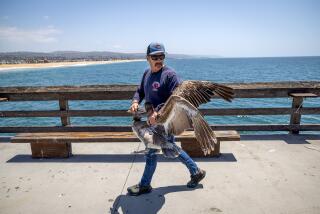Biologist Comes to Chicks’ Rescue
The last thing Southern California Edison workers wanted to do was ruffle feathers.
But when they found two red-tail hawk chicks nesting in a transmission tower in Laguna Beach, they knew the birds would have to go -- at least while they did repairs.
Enter Peter Bloom.
Whenever crews encounter nests with fledglings, they call Bloom. A biologist who specializes in birds of prey, Bloom takes chicks out of harm’s way so that maintenance crews can finish their work. At the end of the day, he puts them back.
So late last month, Edison crews hoisted Bloom more than 60 feet above the ground to the nest. As the chicks’ parents circled and squawked, Bloom scooped the pair with gloved hands and put them in a cardboard box. Then he took them home, where they sat in a pigeon loft for six hours.
“They just hung out,” he said.
Although most people think birds reject chicks handled by humans because of a person’s scent, Bloom said that isn’t true. That adage “has no merit at all with birds of prey,” he said. “They have a poor sense of smell. There’s no way they would detect human scent.”
But that doesn’t mean people should go looking for nests.
“People should stay away from bird nests,” he said, “if for no other reason than their scent might attract mammals to a nest.”
Over the last decade, Bloom estimates that he’s retrieved chicks in similar operations half a dozen times.
He spends most of his time tracking birds and banding their chicks, handling upward of 1,000 birds a year. He also serves as a biological consultant for power companies Southern California Edison and San Diego Gas & Electric, stepping in when workers encounter birds in unexpected places.
But he doesn’t get many calls like the one involving the hawk chicks because power companies often do major maintenance work after chicks have left their nests. The breeding season for raptors lasts from Jan. 1 to July 1.
Days before repairs in Laguna Beach, field crews looked in the nest and called Bloom.
“Our field personnel know these active nests are protected,” said Tracey Alsobrook, a biologist with Southern California Edison.
While the company has put off tree trimming and other maintenance work to accommodate fledglings in the past, the repairs in Laguna Beach -- replacing insulators -- depended on a planned power outage.
“Most red-tail hawks have already fledged from their nests at this time,” Bloom said. The two he picked up in Laguna Beach were less than two weeks from leaving the nest.
Full-grown red-tail hawks weigh about 2 pounds and have a wingspan of 4 1/2 feet. Around Orange County, Bloom said, only a small percentage of birds nest in electricity towers, and they’re usually ravens or red-tail hawks. Most birds build nests in trees.
Bloom said he fed the hawk chicks bits of rat meat before he took them back to their nest.
As for the chicks’ parents, Bloom said, “They were quite pleased to see their kids again.”
He added: “I put several dead rats in the nest to make everybody happy.”
More to Read
Sign up for Essential California
The most important California stories and recommendations in your inbox every morning.
You may occasionally receive promotional content from the Los Angeles Times.










